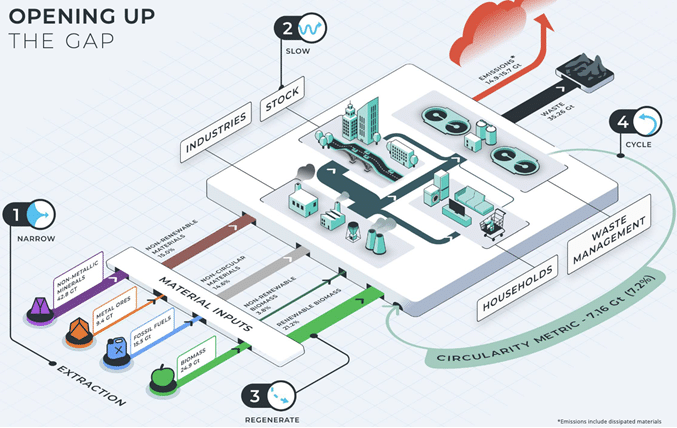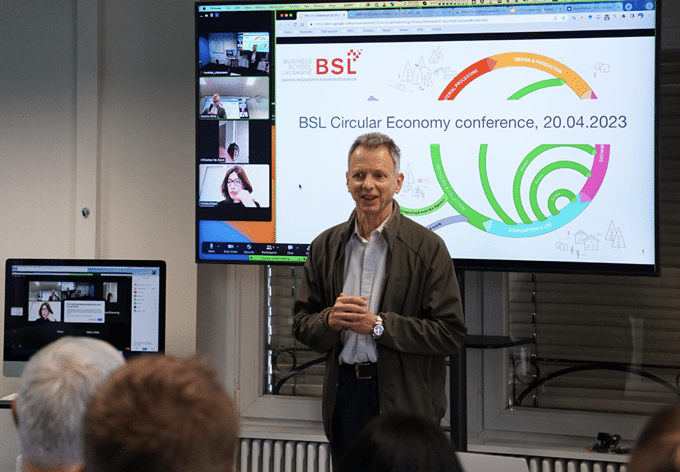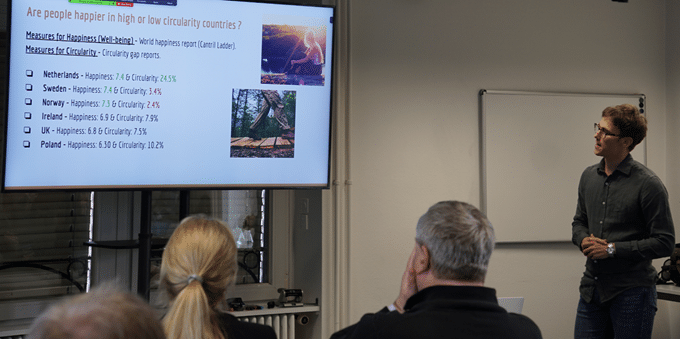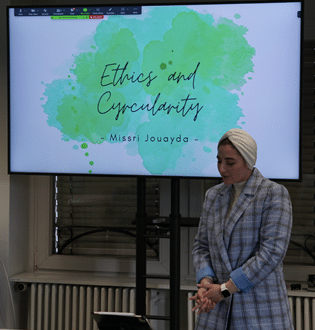
Fig.1: Global circularity gap: minerals, metals, fossil fuels, biomass, (Circle Economy 2023)
On Thursday 20.04.2023, participants of the MIB1031 class “Circular Economy” and I, with the kind support from the BSL Student Council, organized the second annual BSL Circular Economy Conference. It builds on the experience of the 2022 conference, described in this BSL Blog.
The purpose of the conference is to develop a dialogue in the BSL community around this important topic, but also give our master students the opportunity to showcase their work, and gain experience in organizing a small conference bridging science and practice. For students, the conference decision itself, the choice of topics, and all aspects of organization were voluntary and democratically decided.
The conference focused on five hot topics of the Circular Economy, with individual presentations and a panel discussion, followed by a delicious home-made, organic apéritif.

Why focus on the Circular Economy (CE)?
CE is both difficult to understand beyond superficial concepts like reduce-reuse-recycle, and a key topic of the transition to sustainability at almost any organizational level – company, city, canton, country. In scientific terms, it is an “essentially contested” concept, meaning scholars cannot agree on a common meaning, beyond a few basics. However, all serious thinkers can agree that CE organizes the economy to minimize material extraction and waste, using clean energy.
Beyond these very limited common elements, the four main schools of CE of thought differ significantly: Cradle-to-cradle (C2C) separates biological and technical materials, and avoids toxic chemicals in product design and production; whereas Performance Economy (PE) sells the output or outcome of using a product as a service; both are driven by companies, and the main social benefit are service jobs created. On the other hand, the Blue Economy (BE) is led by entrepreneurs with a fine understanding of natural cycles and the local culture, with almost anyone potentially in this entrepreneurial role; Regenerative Design (RD) is community-led and entirely democratic. The first two centralize power and decision-making, with a key role for technology; the last two are embedded in the local community, democratic, and much closer to nature.
Most other CE approaches are much more limited, and take a few elements of the above, for a more or less minimalistic improvement over business-as-usual.
Properly implemented, CE will completely change the structure of the economy, its governance, and power structures. It is also incompatible with continued growth, capital accumulation, or consumerism. This is the fundamental reason why CE is contested, and people cannot agree on what it is.
Still, CE is a necessary but not sufficient condition for sustainability, and therefore key for any company, city, commune, country, school or university.
State of Circularity
The Circularity Gap Report 2018, the first global assessment of circularity, estimated that only 9% of the world’s material use was circular. This metric has been falling every year due to the overall higher global use of materials, by now exceeding 100 Gt annually. The 2023 Circularity Gap Report shows a level of circularity of only 7%, which is likely to fall further, unless material extraction is reduced.
Beyond global estimates, circularity has just been estimated for eight countries: Netherlands, Norway, Sweden, Poland, Northern Ireland, Scotland, the UK, and Switzerland, with the Swiss report published just a month ago, in the middle of our course – this was very fortunate timing.
Key insights of the conference
In the conference, we analyzed these exciting new sources, and tried to answer the following questions:
- How do key country metrics compare per capita; what explains large differences in circularity?
- What insights can low-mid-high circularity countries learn from each other?
- Are people happier in high or low circularity countries?
- What are the ethical implications of circularity transitions?
- Why is CE not profitable (enough) in today’s economy?



It is not easy to summarize everything we learned or discussed, so let me first cite a few participants:
Ali Judeh: “The value of our work became evidently clear as we progressed. Since there is no collective scientific agreement on what the circular economy actually is, any attempt to contribute to an answer holds a certain value. One of the outcomes of our conference was the true power, per capita, we hold in being able to shift our outdated linear ways of thinking towards a more sustainably regenerative future. Therefore, taking part in the organization of such an event truly felt like a constructive step towards a better tomorrow”.
Zachary Hall: “The course gave me great insight into the fundamentals of the Circular Economy and how to structure my research for the question I chose to focus on in the CE conference: Are people happier in high or low circularity countries? In my attempt to answer the question, I found that using the Max-Neef’s Human Scale Development that had been introduced to us in the course was a great way to identify satisfiers of human needs and explore the influential CE schools of thought such as the Regenerative Design Economy. Overall, the course was challenging and has clarified a lot of my preconceptions about the CE. I have acquired new lenses through which to engage in CE discussion and to better analyze new information that is constantly being published about the Circular Economy”.
Kenyan Mayet: “The circular economy presents a promising solution to many of the environmental and economic challenges facing our world today. … It was interesting to analyze the different approaches countries would take towards increasing their circularity rates. … It serves as a guiding vision to drive sustainable and circular practices. Even if the goal is not fully achieved by the target date, the efforts made towards it can still result in significant progress and positive impacts towards a more circular model. As future change agents in the field of work and a huge debate between where the responsibility truly lies in order to implement change, I have had the pleasure to contribute towards sharing the knowledge the new concept of the circular economy proposes which was a great experience to do so with the conference”.
What else did we learn about CE? There are large differences between the countries we analyzed, especially (Switzerland, Norway, Sweden, Scotland, Netherlands, with circularity ranging from 2.4% (NO) to 24.5% (NL). This is mostly explained by real differences such as oil extraction (NO, GB-SCT), and methodology approaches, such as counting cycling of biomass (NL) or not (CH), or taking into account the full impact of import-related material flows. We can expect some harmonization in future editions of Circularity Gap Country Reports.
Countries also have very different circularity goals, probably impossible to reach without reducing the total material use – a key topic not discussed at all by countries. In terms of happiness, there is little difference between low- and high-circularity countries, probably because of a rather technical focus on CE, not (yet) empowering communities, changing satisfiers and culture, or regenerating ecosystems. Regenerative design (RD) holds significant promise, and should be actively pursued.
From an ethics perspective, do rich countries improve their circularity by exporting recycling flows to poor countries, reinforcing poor working conditions and health? Excellent question, which we could not really answer (yet). Finally, why is CE not profitable (enough) in today’s economy? Literature identifies 24 main obstacles to CE, of which several directly impact profitability, and incentives for CE. This is not a shortcoming of CE itself, rather the result of the organization of the rest of society, leading to excessive resource use, inequality, and low or mixed wellbeing. For CE to thrive, society needs to adapt as well.
Next steps
As a key topic bridging sustainability, entrepreneurship, and leadership, CE remains central to BSL. Beyond the dedicated master course (MIB1031), elements of the CE should progressively be included in all relevant courses and research topics, and I invite anyone interested to contact us.
We are also interested in collaborating with companies working on genuine circularity, to learn from new insights, share best practices, or organize student or research projects, and internships.

